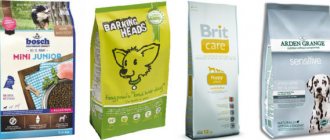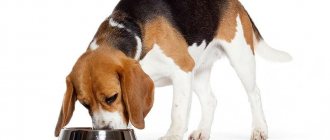The appearance and health of an adult German Shepherd is directly dependent on proper nutrition, starting from the first days of the puppy’s life. An unbalanced diet often leads to digestive problems, skeletal deformities and other pathologies.
To avoid such complications, it is necessary not only to carefully prepare for the arrival of a small pet in the house by studying the characteristics of the breed, but also to find out how to feed a German Shepherd puppy in order to raise a healthy and strong dog.
Basic rules for feeding puppies
From the moment of birth to one and a half years, the puppy’s weight increases 80-90 times. The growth of muscle and bone tissue occurs especially rapidly in the first 4 months. Therefore, it is important to organize proper feeding for up to a year, having thought through the diet. No less important is compliance with basic norms and principles:
- Food is given at certain hours, at the same time.
- For the first 10 days, the diet fed by the breeder is maintained.
- After 20 min. The bowl is removed even if there is food left in it.
- Walks are carried out immediately before or after feeding.
- The maximum break between meals is 8 hours.
- Water must be clean, fresh and constantly available.
- Eating from the ground or floor should not be allowed.
Requirements for space and food bowls
The place where the German is fed is located in a secluded corner where no one bothers him. Bowls with water and food should be placed at such a height that the puppy's head is parallel to the floor while eating. A strong forward bend threatens the German Shepherd with curvature of the spine, joints and neck. If the bowl is placed incorrectly, the dog may swallow air, which can lead to bloating. The optimal height is achieved using a special adjustable tripod stand. The cup is placed so that its upper edge is at the level of the animal’s chest.
The optimal volume of dishes for feeding a German Shepherd is 1.8 liters. The most preferred material is metal. This bowl is easy to wash and the dog cannot chew it.
Portion size
When feeding, it is necessary to take into account the dog's metabolic rate and stomach volume. At first, food is given often and in small portions, later the time intervals and volume of food are increased. Follow the approximate diagram:
- up to 1.5 months of age, the puppy is fed frequently, with a serving size of 200 ml;
- from 1.5 to 3 months – 300 ml;
- from 3 to 6 months – 500 ml;
- from 6 to 10 months – 0.75-1 l;
- per year - 1-1.5 liters.
Feeding schedule
The number of feedings per day depends on the age of the puppy. Free feeding is unacceptable, since overfeeding threatens a German with obesity, and a lack of food can result in stunted growth and development. Starting from 3-4 weeks, babies are gradually transferred from breast milk to regular food, adhering to the schedule:
- from 4 weeks to one and a half months, the shepherd dog eats 6 times a day;
- from 1.5 to 3 months they feed five times;
- from 3 to 6 months – four times;
- from 6 to 10 months – three times;
- From the age of one year they are switched to two meals a day.
If for any reason a meal was missed, there is no need to increase the portion. With a well-designed diet, the remaining volume is sufficient for a small dog, but if the portion is increased, overfeeding is possible.
Contacts with strangers
With proper upbringing of a puppy, his attitude towards other people (if they do not show aggression) will be a complete disregard for strangers.
This is achieved through the hard work of the owner:
- Firstly, prohibit everyone except family members from playing with the puppy, stroking it, calling it to you, touching it, etc.;
- Secondly, explain to anyone who wants to approach you or show any emotional actions towards your dog when you are walking with the puppy that this should not be done.
Achieve this. Unfortunately, many people do not understand the stages of raising a dog and perceive such a request as a personal insult. If the owner is a weakling (by character), then it will not be possible to instill the skill of concentration on the owner.
The best way to distract your puppy's attention from a stranger is to attract the dog with a piece of treat. In each case, when your puppy becomes interested in strangers, call the puppy softly, pull the leash towards you and reward him with a treat.
In this way you will discourage the puppy from showing interest in strangers. They will simply not be interesting to him.
When walking in new places, if the dog begins to get nervous, turn the attention to yourself in the same way.
Never allow strangers to feed your puppy. This way you will teach the dog to be interested in strangers and all your upbringing will go to waste.
Rules for feeding German puppies
Normally, puppies feed on their mother's milk until they are one month old. After four weeks, complementary foods are gradually introduced.
If the German Shepherd has a large litter or the bitch does not have enough milk, the babies are fed by hand using a pipette, a syringe without a needle, or a baby bottle. They use special mixtures that are purchased at a veterinary pharmacy, goat, cow or sheep milk. Before consumption, food is heated to 28 ⁰C. Until the age of 2 weeks, feed ten times a day, using 150 ml of the mixture. From the 3rd week, increase the portion by 100 ml, and by the end of the month bring it to 400 ml and give it six times a day.
Possible diseases and methods of treating them
You cannot call a German Shepherd a weak and sickly dog, but there are factors that will certainly undermine its health. The main one is unhealthy diet. If your pet sleeps a lot, defecates frequently and refuses to eat, this is a warning sign. His digestion was probably disrupted.
A sick dog should be taken to an animal clinic and seen by a specialist. In most cases, digestive dysfunction in dogs is treated by taking sorbents. The veterinarian will prescribe the medicine and determine the dosage. You can give sorbents to your pet yourself at home.
Almost all German Shepherds have a genetic defect - weak, inelastic leg joints. When the dog is not injured, the pathology does not manifest itself in any way, but if it falls, for example, on ice, it will easily damage a limb. Painkillers will help the animal.
The German Shepherd is not only a fearless bodyguard, but also a loyal and affectionate friend. She will always come to the aid of people who love her and will never leave them of her own free will.
When can a puppy be given complementary foods?
Two weeks after birth, you can start feeding the puppies. During this period, they are still breastfed, but for full development, the babies’ bodies need new nutrients. At 14 days they can be given minced lean beef, finely chopped and scalded tripe or heart, rice porridge with milk mixed with water in a 1:1 ratio. At three weeks the German is fed cottage cheese, yogurt and kefir. At four weeks, hard-boiled eggs are added to the diet. Vegetables, berries and fruits are given in small quantities.
For the first time, complementary feeding should be 15-20 g, which corresponds to half a tablespoon. In the future, the rate of any food fed per day should gradually increase:
- at 2.5 weeks – 100 ml;
- at 3 weeks – 150 ml;
- at 4 weeks – 200 ml.
Feeding a German Shepherd puppy by month
The owner chooses the type of adult food for a young German Shepherd. When using industrial food, there is no need to develop a menu, while “natural” food can diversify a puppy’s diet from one month of age to adulthood. Over time, it becomes more extensive, single and daily portions increase. The table shows foods that can be fed to a German Shepherd for up to a year with an approximate daily dosage. It is adjusted depending on the size of the pets, their appetite and other individual characteristics.
| Type of feed | German Shepherd age | |||||||
| At 1 month | At 2 months | At 3 months | At 4 months | At 5 months | At 6 months | At 7 months | From 8-12 months | |
| Meat | 100 g | 180 g | 270 g | 350 g | 450 g | 600 g | 700 g | 750 g |
| Porridge | 120 g | 150 g | 200 g | 250 g | 300 g | 400 g | 500 g | 300 g |
| Fish | — | 300 g | 450 g | 600 g | 800 g | 900 g | 1000 g | 1200 g |
| Vegetables | 50 g | 120 g | 150 g | 200 g | 260 g | 350 g | 400 g | 420 g |
| Milk | 80 g | 180 g | 200 g | 330 g | 400 g | 450 g | 500 g | 500 g |
| Kefir | 150 g | 250 g | 400 g | 500 g | 1500 g | 1500 g | 1000 g | 1000 g |
| Cottage cheese | 120 g | 300 g | 350 g | 400 g | 500 g | 700 g | 750 g | 1000 g |
| Eggs (per week) | ½ yolk | 1 yolk | 1 yolk | 2 yolks | 2 eggs | 2 eggs | 2 eggs | 2 eggs |
| Salt | 3 g | 3 g | 4 g | 4 g | 5 g | 5 g | 8 g | 8 g |
| By-products | — | — | — | 200 g | 400 g | 1000 g | 1500 g | 1200 g |
| Vegetable oil | — | 5 g | 7 g | 10 g | 15 g | 15 g | 20 g | 20 g |
Behavior at home
Communicate and play with your puppy as often as possible, do not ignore him. Practice and reinforce the general commands “Ugh!”, “No!”, “Come to me!”. Do not train your dog to jump on its owner. When giving the command “Come!”, if the puppy rushes towards you and tries to stand on you with its front paws, take a step back and give the command “Ugh!”, over time the puppy will realize that with this behavior the communication will stop and will soon stop doing this. With the right approach, be sure to reward the puppy.
If the puppy is not in an enclosure (if you live in an apartment, determine a place for a small dog run, where the puppy has a designated place and will be given the opportunity to walk around the clock without restrictions), then carry out all movements around the house and the surrounding area by leading the dog exclusively on a leash, limiting his movement. The dog cannot be given complete freedom of action at this stage of development; reinforce the skill - you are the leader, the leader, the dog’s freedom is in your will. For complete freedom, the puppy has an enclosure and games with the owner. Such restrictions are very important when raising a German Shepherd, because you are raising a serious service dog, a protector dog, a formidable force, and not a decorative lap dog.
What to choose - dry food or natural food
Many dog breeders choose industrial food for their German Shepherd, since it contains the necessary complex of microelements, vitamins, vegetables and meat. Ready-made granules are easy to use: there is no need to develop a diet; the serving size for any age is indicated on the product packaging. When choosing natural food, you can be confident in the freshness and quality of the products, and create a varied menu for your puppy, based on his taste and preferences.
Prohibited Products
It is forbidden to feed your dog most of the foods found on the human table. Even if your pet looks with pitiful eyes, begging for a tasty morsel, you must be firm.
A German Shepherd cannot be fed:
- fatty meat;
- salted, smoked, pickled, fried foods;
- food with a lot of spices and herbs;
- sausages;
- sweets and baked goods;
- fish and tubular bones;
- citrus fruits, fruits with seeds;
- coffee, carbonated and alcoholic drinks;
- nuts;
- legumes
These products disrupt the functioning of the body, leading to systemic diseases and poisoning.
A puppy and an adult German Shepherd can be fed natural food or industrial food - the choice falls on the shoulders of the dog breeder. But in any case, the food must be of high quality, otherwise the pet will have health problems.
How much food should I give my kitten?
The dosage of dry food depends on its quality. Super-premium products contain all the necessary elements, which allows them to surpass natural food in nutritional value. It is economical, the portions are small, the size depends on the purpose of raising the German Shepherd, the weight of the parents and the intensity of the pet’s development.
You can find out how much dry food you should give your puppy at different ages from the table:
| Age in months | Puppy weight | Feed quantity |
| 2 | 7.6 kg | 240 g |
| 4 | 13.5 kg | 310 g |
| 6 | 18 kg | 350 g |
| 8 | 26 kg | 428 g |
| 10 | 35 kg | 432 g |
Friendship between a shepherd dog and a child 5-14 years old
Whether a German Shepherd and a child will get along at this age depends largely on the child. The parent should independently assess whether the younger family members are ready for such a neighborhood.
The German Shepherd will be happy to actively spend time with the child: run, jump and play.
Children must understand that:
the dog has daily needs and needs to be looked after; a pet is not a toy, it has its own desires and plans that must be taken into account; animals experience pain and must be handled with care; the role of a dog in society and the danger to other people; harm and benefit of various phenomena and products for the new resident.
The child can and should be trusted with part of the daily care of the pet. The German Shepherd enjoys spending time with children in active games. If the child treats the dog with respect, there is no need to be afraid to leave them alone.
Natural feeding of a puppy
Despite the fact that preparing meals from natural products for a German Shepherd takes time, the option is more varied and healthier. The animal receives everything necessary for the body. The diet should consist of 60% protein, 35% cereals, vegetables, fruits, 5% treats, vegetable oil.
So, the approximate daily diet of a 2-month-old puppy includes:
- a portion of porridge with milk;
- cottage cheese with kefir;
- porridge on water with the addition of meat and vegetables;
- boiled beef or chicken;
- vitamins.
Vegetables and fruits
Small German Shepherds get used to eating vegetables and fruits, which are sources of vitamins, mineral salts, organic acids and starch. Cucumbers, cabbage, tomatoes, zucchini are given raw or boiled. Carrots must be chopped and vegetable oil added to it. Berries and apples are fed along with cottage cheese. It is worth remembering that cherries are weakened, potatoes are given only raw as a treat, sorrel can cause gastritis and more severe health consequences in a German shepherd.
Fish and seafood
A German Shepherd's diet should include raw or cooked sea fish. It is lower in calories than meat, contains a high percentage of phosphorus, iodine, fluorine, sulfur, vitamins A and B.
The dog is first introduced to fish and seafood at 2-3 months of age. Bones, fins, and tails are first removed. Neither puppies nor adult German Shepherds should be fed river fish due to the large number of bones and the high risk of helminth infection.
By-products
By-products cannot replace meat, but their composition is rich in vitamins and minerals, so they are required to be included in the diet of a German Shepherd. 3-4 month old puppies are given a heart, kidneys, liver, tripe and lungs. Their volume should be one and a half times larger than meat. The exception is the heart, the amount of which in the menu is a quarter less than beef, chicken or turkey.
Meat
The main source of energy for the German Shepherd is meat. It is given raw and boiled, with preference given to the first option. Already at one month of age, it is introduced into the diet, first in the form of minced meat and scrapes, and later – finely chopped. They use chicken, beef, turkey and rabbit. Freeze for three days before serving. You should not feed your German Shepherd fatty foods - pork, lamb, duck and goose.
Cereals
Porridge should be on the German menu starting from the age of one month. Dogs are fed oatmeal, rice and buckwheat. To gain weight, use semolina, barley and wheat cereals. Due to difficult digestion and absorption, you should not feed millet, pearl barley and legumes.
Milk and lactic acid products
Milk is fed to babies up to 2 months; later it is rarely given, since an adult dog cannot digest it fully due to the lack of enzyme production.
Cottage cheese is the most beneficial for German Shepherds. Kefir, yogurt, fermented baked milk and yogurt have a positive effect on the functioning of the gastrointestinal tract. Cheese is used only as a treat during training. It is not recommended to mix fermented milk products with meat and vegetables.
How to distinguish a breed from a crossbreed or mongrel
The surest way to purchase a purebred German Shepherd is to do so from a reliable kennel. Then the puppy will have a pedigree, a metric (puppy card), a brand with a unique number in the groin or on the ear. And you won’t have to guess whether you bought a purebred dog or not. When buying from private breeders or on the market, there is always a risk of making a mistake, because an amateur is unlikely to be able to correctly evaluate the breed. In this case, decide on the purpose: why you need a dog. To participate in exhibitions and breeding work, you need to look for a puppy only in nurseries with a good reputation. For official or security work - in the same place, because the character of a real German Shepherd, which made it a legend and a movie star, is also a sign of the breed. But then appearance is not so important, and the dog will cost much less.
The new owner signs the puppy inspection report (below) and the certificate is certified with a seal
If you want to have a companion dog with the appearance of a German Shepherd, then you can take the risk of purchasing it on the market or through “buy and sell” advertisements, but at the same time remember that a grown-up pet may unpleasantly surprise you with its difference from true “Germans”. There are signs by which you can try to distinguish a purebred puppy from a mestizo or mongrel:
- “Germans” have almond-shaped eyes with snow-white whites, while mongrel dogs have round, sometimes convex, eyes with yellowish whites or dark spots;
- an ordinary puppy cannot boast of a perfectly smooth topline and a body elongated like a torpedo;
- the tail of a small shepherd never rises above the line of the back and does not curl into a ring, like that of mongrels;
- The ears of a “German” should be floppy and soft for at least 4–5 months, while a mongrel’s ears may stand up at any time or not at all;
- A purebred baby does not have a stripe between the eyebrows (frontal furrow) on the forehead, but a purebred baby may have one;
- A shepherd puppy grows and develops much faster than a yard puppy, so at the same age he will weigh more and look more mature.
A “German” puppy is more inclined to communicate with a person than a mongrel puppy
Video: how to choose the right German Shepherd
Recipes for a German Shepherd Puppy
To prepare a main dish for a German Shepherd, you can use a recipe that includes the following ingredients:
- bone with meat – 500 g;
- beef by-products – 150-300 g;
- rice – ½ cup;
- buckwheat – ½ cup;
- carrots – 1 pc.;
- tomato – 1 pc.;
- zucchini – 100 g.
Preparation procedure:
- Boil broth on bones and meat.
- Chop the vegetables and mix with a blender.
- Finely chop offal.
- Remove the bone, add vegetables, offal and grains to the broth.
- Cook until done.
The recipe can be modified by adding other vegetables, cereals and seaweed.
Nutrition for dogs prone to allergies
Food allergies in a German Shepherd can be caused by:
- dry food with artificial additives;
- chicken eggs;
- red vegetables and fruits;
- mussels, shrimp and other seafood.
Before allergens are identified, Germans are fed white sea fish, lean beef, turkey, oatmeal, buckwheat or rice porridge, natural dairy products, fruits and green vegetables.
Vitamin supplements for puppies
The vitamin and mineral complex should become an integral part of the natural diet of the German Shepherd. Dogs can accept:
- nutritional yeast;
- fish fat;
- bone meal;
- vitamins A, E, D.
- sulfur
It is possible to use a ready-made vitamin complex, which a veterinarian will help you choose based on test results and observations of your German Shepherd puppy.
When using high-quality industrial feed, additional fortification is not required.
Walk
It is common knowledge that dogs need walks in the fresh air. And when it comes to shepherd puppies, the more time they spend outside, the stronger their immunity becomes. However, all this applies only to older children.
If we are talking about a two-month-old baby, then it is best for them to be in an apartment or house. Up to 4-6 months, puppies are taken out for walks, just so that the dog gets used to the street and can relieve itself.
All dogs love to go outside
Raising and caring for puppies is a complex and tedious process, just like caring for any child. The owner should be patient and closely monitor the pet. A proper diet, exercise, and walks in the fresh air will help raise your furry baby into a big and loyal dog who will sincerely love his owner. Don’t forget about training, which will help correct the character of the little mischief-maker.











